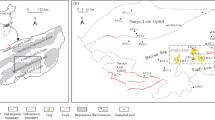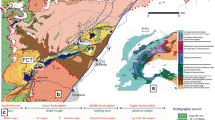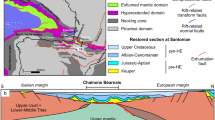Abstract
In the Northern Emirates, Jurassic and Lower Cretaceous platform carbonates of the Musandam parautochthonous units are tectonically overlain by siliciclastic units of the Hawasina–Sumeini allochthon, which derive from the former paleo-slope domain and a more distal basinal portion of the Arabian margin of the Tethys, respectively. All these tectonic units display numerous evidences of paleo-fluid circulations, accounting for dolomitisation and recrystallisation of the rock matrix (Musandam Platform units), as well as cementation of fractures. Polymict breccias of Upper Cretaceous Ausaq Formation which underlay the sole thrust of the Hawasina–Sumeini allochthon also record episodes of hydraulic fracturing, whereas fluid inclusion data indicate precipitation at high temperature in relation to paleo-fluid flow. Petrography of thin-sections (conventional and cathodoluminescence microscopic techniques) as well as fluid inclusion and stable isotopes analyses, were combined with micro-tectonic studies. These analytical data document (1) the paragenetic sequence of diagenetic products for the Musandam Platform (which constitutes a carbonate reservoir analogue) and Sumeini units of the Dibba Zone, as well as (2) the nature of the paleo-fluids circulating along fractures and the sole thrust of the Hawasina–Sumeini allochthon. The main results of this petrographic approach are qualitative, evidencing (1) the rapid and vertical transfer of hot fluids in the vicinity of the former slope to platform transition, accounting for episodes of hydrothermal dolomitisation, as well as (2) early (i.e. pre-orogenic) and late (i.e. post-orogenic) episodes of emersion of the carbonate units, accounting for additional interactions with meteoric fluids and karstification. In order to better link these diagenetic events with the overall burial, thermal and kinematic evolution of the Arabian margin, basin modelling with Ceres2D, including fluid flow and pore-fluid pressure modelling, was subsequently performed along a regional transect (D4) located in the vicinity of the samples localities and cross-cutting the Northern Oman Mountains from Dibba in the east up to the Arabian Gulf in the west. New subsurface constraints provided by deep seismic profiles were used to constrain the architecture of the cross-section, and to test various hypotheses on the lateral and vertical connection, timing and hydrodynamic behaviour of the faults. This Ceres basin modelling also provides new quantitative estimates of the paleo-fluid pathways, of the timing and velocities of the fluid transfers and of the evolution of pore-fluid pressures. Ultimately, this integration of petrographic studies on surface samples and coupled kinematic and fluid flow basin modelling provides an updated scenario for the succession of tectonically controlled episodes of fluid rock interactions, namely dolomitisation and karstification recorded in the Mesozoic platform carbonates of the Northern Emirates.
Abstract
في شمال الامارات تعلو وحدات من الصخور الفتاتيةHawasina-Sumeini تكتونيا وحدات صخور الكربونات Musandam parautochthonous والتي تعود للجوراسي والكريتاسي السفلي. كل هذه الوحدات التكتونية تظهر عدة ادلة لحدوث عملية تدوير للسوائل والتي تعتبر مسؤولة عن عمليات الدلمتة وإعادة التبلور لمادة الارضية لصخور الـ Musandam Platform بالإضافة الى عملية تشكيل المادة اللاحمة في الكسور. صخور البريشيا التابعة لمتكون Ausaq المنتمي للكريتاسي العلوي واللذي يقع تحت وحدات الـ Hawasina-Sumeini allochthon ايضا تسجل حدوث بعض الفترات من التكسر الهيدروليكي في حين تشير دراسة السوائل المكتنفة الى ترسب في درجات حرارة عالية بالمقارنة لنمط جريان السوائل القديمة.تم إضافة الدراسة البتروجرافية للشرائح الصخرية باستخدام تقنية المجاهر التقليدية و تقنية الـ cathodoluminescence المجهرية ودراسة وتحليل مكتنفات السوائل والنظائر غير المشعة مع دراسة التكتونية الدقيقة بهدف جمع البيانات اللازمة. هذه البيانات التحليلية تبين التالي: (1) التتابع المتسلسل والوثيق لنواتج النشأة المابعدية للـ Musandam Platform و وحدات الـ Sumeini التابعة لنطاق الـ Dibba و (2) طبيعة تدوير السوائل القديمة على طول الكسور و الصدع الموجود في اسفل الـ Hawasina-Sumeini allochthon.
النتائج النوعية الرئيسية لهذا الاسلوب البتروجرافي تثبت (1) الانتقال السريع والعمودي للسوائل الحارة في منطقة المنحدر السابق الى المنطقة الانتقالية لل platform والذي كان السبب في حدوث حالات من الدلمتة الحرمائية و (2) وجود حالات انكشاف مبكرة (قبل العملية التكتونية) ومتأخرة (بعد العملية التكتونية) للوحدات الصخرية الجيرية مسببة المزيد من التفاعل مع السوائل الخارجية و تكوين الطبوغرافية المعروفه بـ Karstification.
للربط بين عمليات النشأة التأخرة التي حدثت مع مجمل التطور في الحافة العربية من ناحية الدفن والحرارة والحركة تم عمل نمذجة للحوض الرسوبي باستخدام Ceres 2-D بالاضافة الى نمذجة حركة السائل وضغط السائل الموجود في المسامات على طول القطع الاقليمي (D4)والموجود في النطاق المحتوي على مناطق العينات المجموعة والذي يقطع بشكل عرضي جبال شمال عمان من الـDibba في الشرق والى الخليج العربي في الغرب. تم استخدام المسح السيزمي العميق لايجاد قيود تحت سطحية جديدة والتي تم استخدامها لتحديد البنية الداخلية للقطاع العرضي ولأختبار عدة فرضيات تتعلق بــ العلاقة الجانبية والعمودية والتوقيت والسلوك الهيدروديناميكي للصدوع.
هذا النوع من النمذجة يعطي ايضا تقديرات كمية جديدة لممرات السوائل القديمة ولتوقيت وسرعات انتقال هذه السوائل ولتطور ضغوط السائل الموجود في المسامات. ان هذا الدمج بين الدراسات البتروجرافية على العينات السطحية وبين نمذجة الاحواض الرسوبية من حيث الحركة وجريان السائل يوفر رؤية حديثة لتتابع حالات التفاعل بين السائل والصخرو المحكومة بالعوامل التكتونية, وتحديدا عمليات الدلمتة والطبوغرافية العروفة بـ karstificationالموجودة في صخور الكربونات التابعة للـ Mesozoic في شمال الامارات.














Similar content being viewed by others
References
Alsharhan AS (1989) Petroleum geology of the United Arab Emirates. J Petrol Geol 12:253–288
Benchilla L, Guilhaumou N, Mougin P, Jaswal T, Roure F (2003) Paleoburial and pore pressure reconstruction of reservoir rocks in foothills areas: a sensitivity test in the Hammam Zriba (Tunisia) and Koh-I-Maran (Pakistan) ore deposits. Geofluids 3:103–123
Blinton JS, Wahid IA (1983) A review of Sajaa field development, Sharjah. United Arab Emirates, 3rd Middle East Oil Show, SPE Bahrain, pp. 601–606
Boote DRD, Mou D, Waite RI (1990) Structural evolution of the Suneinah foreland, Central Oman Mountains. In: Robertson AHF, Searle MP, Ries AC (eds) The geology and tectonics of the Oman region, Special Publication, 49. Geological Society, London, pp 397–418
Breesch L (2008) Diagenesis and fluid system evolution in the Northern Oman Mountains, UAE. PhD Thesis, KU Leuven, Belgium, 159 p
Breesch L, Swennen R, Vincent B (2006) Dolomite formation in breccias at the Musandam Platform border, Northern Oman Mountains, UAE. J Geochem Explor 89(1–3):19–22
Breesch L, Swennen R, Dewever B, Mezini A (2007) Deposition and diagenesis of carbonate conglomerates in the Kremenara anticline, Albania: a paragenetic time marker in the Albanian foreland fold-and-thrust belt. Sedimentology 54(3):483–496
Breesch L, Swennen R, Vincent B (2009) Fluid flow reconstruction in hanging and footwall carbonates: compartmentalization by Cenozoic reverse faulting in the Northern Oman Mountains (UAE). Mar Petrol Geol 26(1):113–128
Breesch L, Swennen R, Vincent V, Ellison RA, Dewever B (2010a) Dolomite cementation and recrystallisation of sedimentary breccias along the Musandam Platform margin (UAE). J Geochem Explor 106(1–3):34–43
Breesch L, Swennen R, Dewever B, Roure F, Vincent B (2010b) Diagenesis and fluid system evolution in the Northern Oman Mountains. Implications for petroleum exploration, UAE, in review
Callot JP, Roure F (2007) Petroleum systems appraisal and Ceres modelling of the Emirates D4 section. Ministry of Energy, UAE-IFP report
Dunne LA, Manoogian PR, Pierini DF (1990) Structural style and domains of the Northern Oman Mountains (Oman and United Arab Emirates). In: Robertson AHF, Searle MP, Ries AC (eds) The geology and tectonics of the Oman region, Special Publication, 49. Geological Society, London, pp 375–386
Eilrich B, Grötsch J (2003) The Lower Cretaceous carbonate slope-to-platform-margin succession near Khatt, United Arab Emirates: sedimentary facies and depositional geometries. GeoArabia 8(2):275–294
Ellison RA, Woods MA, Pickett EA, Arkley SLB (2006) Geology of the Al Rams 1:50 000 map sheet, 50-1, United Arab Emirates. British Geological Survey, Keyworth, p 42
Ellison RA, Phillips ER, Styles MT (2009) A geostraverse across the Late Cretaceous fold and thrust belt of the UAE: from ophiolite to platform margin. Guide for Dibba Zone field excursion, ILP Task Force on Sedimentary Basin, BGS-Ministry of Energy of the UAE, p. 31
Faille I, Nataf F, Schneider F, Willien F (1998) Domain decomposition methods for fluid flows in porous medium: ECMOR, 6th European Conference on the Mathematics of Oil Recovery, Peebles, September 8–11, 1998, Proceedings, Paper B-06, p. 6
Ferket H, Ortuño S, Swennen R, Roure F (2003) Diagenesis and fluid flow history in reservoir carbonates of the Cordilleran fold- and thrust- belt: The Cordoba Platform. In Bartolini C, Burke K, Buffler R, Blickwede J, Burkart B (eds) Mexico and the Caribbean region: plate tectonics, basin formation and hydrocarbon habitats, AAPG Memoir 79, Ch. 10, pp. 283–304
Ferket H, Swennen R, Ortuño-Arzate S, Cacas MC, Roure F (2004) Hydrofracturing in the Laramide foreland fold-and-thrust belt of Eastern mexico. In: Swennen R, Roure F, Granath J (eds) Deformation, fluid flow and reservoir appraisal in foreland fold-and-thrust belts, vol. 1. AAPG Hedberg, Memoir, pp 133–156
Glennie KW, Boeuf MGA, Hughes-Clarke MW, Moody SM, Pilaar WFH, Reinhardt BM (1974) Late Cretaceous nappes in Oman Mountains and their geologic evolution. AAPG Bull 57:5–27
Graham GM (1980a) Evolution of a passive margin, and nappe emplacement in the Oman Mountains. In Panayiotou A (ed.), Proceedings, International Ophiolite Symposium, Cyprus, 1979, pp. 414–423
Graham GM (1980b) Structure and sedimentology of the Hawasina window, Oman Mountains. PhD Thesis. Open University, UK
Hamdan ARA (1990) Maastrichtian Globotruncanids from the western front of the northern Oman Mountains: implications for the age of post-orogenic strata. J Fac Sci, United Arab Emirates Univ 2:53–66
Hanna SS (1986) The Alpine (late Cretaceous and Tertiary) tectonic evolution of the Oman Ranges: a thrust tectonic approach. In OAPEC/Symposium on the hydrocarbon potential of intense thrust zones, vol. 2. Abu Dhabi, pp. 125–174
Hanna SS (1990) The Alpine deformation of the Central Oman Mountains. In: Robertson AHF, Searle MP, Ries AC (eds) The geology and tectonics of the Oman region, Special Publication, 49. Geological Society, London, pp 341–359
Jahani S, Callot JP, Letouzey J, Frizon de Lamotte D (2009) The eastern termination of the Zagros fold-and-thrust belt, Iran: structures, evolution, and relationships between salt plugs, folding and faulting. Tectonics, doi:10.1029/2008TC002418, 2009
Lacombe O, Malandain J, Vilasi N, Amrouch K, Roure F (2009) From paleostresses to paleobutrial in fold–thrust belts: preliminary results from calcite twin analysis in the outer Albanides. In The geology of vertical movements of the lithosphere, vol. 475. Tectonophysics, pp. 128–141, doi:10.1016/j.tecto.2008.10.023
Lippard SJ, Smewing JD, Rothery DA, Browning P (1982) The geology of the Dibba Zone, northern Oman Mountains; a preliminary study. J Geol Soc Lond 139:59–66
Machel HG, Cavell PA (1999) Low-flux, tectonically-induced squeegee fluid flow (“hot flash”) into the Rocky Mountain foreland basin. Bull Canadian Petrol Geol 47:510–533
Naville C, Ancel M, Andriessen P, Ricarte P, Roure F (2010) New constrains on the thickness of the Semail Ophiolite in the Northern Emirates. This volume
O’Donnell GP, Daly CB, van Mount S, Krantz RW (1994) Seismic modelling over the Margham field, Dubai, United Arab Emirates. In: Al Husseini MI (ed) GEO’94, vol. II. The Middle East Petroleum Geosciences, Bahrain, pp 737–746
Oliver J (1986) Fluid expelled tectonically from orogenic belts: their role in hydrocarbon migration and other geologic phenomena. Geology 14:99–102
Patton TL, O’Connor SJ (1986) Cretaceous flexural history of the northern Oman Mountain foredeep, United Arab Emirates. In Hydrocarbon potential of intense thrust zones, vol. 1. Abu Dhabi Conference, pp. 75–120
Patton TL, O’Connor SJ (1988) Cretaceous flexural history of northern Oman Mountain foredeep. United Arab Emirates. AAPG Bull 72:797–809
Phillips ER, Ellison RA, Farrant AR, Goodenough KM, Arkley SLB, Styles MT (2006) Geology of the Dibba 1:50 000 map sheet, 50-2, United Arab Emirates. British Geological Survey, Keyworth, p 59
Ricateau R, Riché PH (1980) Geology of the Musandam peninsula (Sultanate of Oman) and its surroundings. J Petrol Geol 3(2):139–152
Robertson AHF, Blome CD, Cooper DWJ, Kemp AES, Searle MP (1990) Evolution of the Arabian continental margin in the Dibba Zone, Northern Oman Mountains. In: Robertson AHF, Searle MP, Ries AC (Eds), The geology and tectonics of the Oman region. Geol. Soc. Spec. Publ. 49, pp. 251–284
Roure F (2008) Foreland and hinterland basins: What controls their evolution? Swiss Journal of Geosciences, Birkhaüser Verlag, Basel, doi:10.1007/s00015-008-1285-x
Roure F, Swennen R, Schneider F, Faure JL, Ferket H, Guilhaumou N, Osadetz K, Robion PH, Vendeginste V (2005) Incidence and importance of Tectonics and natural fluid migration on reservoir evolution in foreland fold-and-thrust belts. In: Brosse E et al (eds) Oil and Gas Science and Technology, Oil and Gas Science and Technology, Revue de l’IFP, 60, 67–106
Roure F, Andriessen P, Breesch L, Broto K, Bruneau J, Chérel L, Collin M, Ellouz N, Faure JL, Guilhaumou N, Jardin A, Muller C, Naville CH, Ricarte P, Rodriguez S, Swennen R, Tarapoanca M (2006) Deep seismic survey in the Northern Emirates, Part II: Main interpretation and modelling report. Ministry of Energy, UAE-IFP Report n° 59 359, p. 125
Roure F, Cloetingh S, Scheck-Wenderoth M, Ziegler P (2009) Achievements and challenges in sedimentary basins dynamics. In: Cloeting S, Negendank G (eds) International Year of Planet Earth, Special Volume on Deep Earth, Chaper 5. Springer
Roure F, Callot JP, Ferket H, Gonzales E, Guilhaumou N, Lacombe O, Malandain J, Mougin P, Swennen R, Vilasi N (2010) The use of paleo-thermo-barometers and coupled thermal, fluid flow and pore fluid pressure modeling for HC and reservoir prediction in Fold and Thrust belts. In: Goffey GP, Craig J, Needham T, Scott R (eds) Hydrocarbons in Contractional Belts. Geological Society, London, Special Publications 348, pp. 87–114, doi:10.1144/SP348.6
Sassi W, Rudkiewicz JL (2000) Computer modelling of petroleum systems along regional cross-sections in foreland fold and thrust belts. In Geology and Petroleum Geology of the Mediterranean and Circum Mediterranean Basins, Malta, Proceedings, Extended Abs., C27–1–4
Schneider F (2003) Basin modelling in complex area: examples from eastern Venezuelan and Canadian foothills. Oil Gas Sci Technol Revue de l’IFP 58(2):313–324
Schneider F, Devoitine H, Faille I, Flauraud E, Willien F (2002) Ceres2D: a numerical prototype for HC potential evolution in complex area. Oil Gas Sci Technol Revue de l’IFP 57(6):607–619
Searle MP (1985) Sequence of thrusting and origin of culminations in the northern and central Oman mountains. J Struct Geol 7:129–143
Searle MP (1988a) Thrust tectonics of the Dibba Zone and the structural evolution of the Arabian continental margin along the Musandam Mountains (Oman and UAE). J Geol Soc London 145:53–63
Searle MP (1988b) Structure of the Musandam culmination (Sultanate-of-Oman and United-Arab-Emirates) and the Straits of Hormuz Syntaxis. J Geol Soc 145:831–845
Searle MP, James NP, Calon TJ, Smewing JD (1983) Sedimentological and structural evolution of the Arabian continental margin in the Musandam Mountains and Dibba Zone, United Arab Emirates. Geol Soc Am Bull 94(12):1381–1400
Sindhu B, Suresh I, Unnikrishnan AS, Bhatkar NV, Neetu S, Michael GS (2007) Improved bathymetric datasets for the shallow water regions in the Indian Ocean. J Earth Syst Sci 116:261–274
Styles MT, Ellison RA, Arkley SLB, Crowley Q, Farrant A, Goodenough KM, McKervey JA, Pharaoh TC, Phillips ER, Schofield D, Thomas RJ (2006) The geology and geophysics of the United Arab Emirates. British Geological Survey, Keyworth
Swennen R, Muska K, Roure F (2000) Fluid circulation in the Ionian fold and thrust belt (Albania): Implications for hydrocarbon prospectivity. J Geochem Explor 69:629–634
Swennen R, Roure F, Granath J (eds) (2004) Deformation, fluid flow and reservoir appraisal in foreland fold and thrust belts. AAPG Hedberg Series, Memoir 1, p. 430
Tarapoanca M, Andriessen P, Broto K, Chérel K, Ellouz-Zimmerman N, Faure JL, Jardin A, Naville C, Roure F (2010) Forward kinematic modelling of a regional transect in the Northern Emirates, using apatite fission track age determinations as constraints on paleo-burial history. This volume
Van Geet M, Swennen R, Durmishi C, Roure F, Muchez Ph (2002) Paragenesis of Cretaceous to Eocene carbonate reservoirs in the Ionian foreland fold-and-thrust belt (Albania): Relation between tectonism and fluid flow. Sedimentology 49:697–718
Vandeginste V, Swennen R, Gleeson SA, Ellam RM, Osadetz K, Roure F (2005) Zebra dolomitization as a result of focused fluid flow in the Rocky Mountains Fold-and-Thrust belt, Canada. Sedimentology 52:1067–1095
Vilasi N (2003) Caractérisation des paléofluides et reconstruction de l’histoire de l’enfouissement et de la température de réservoirs pétroliers dans la chaîne d’Oman et son avant-pays. Master, Univ. Paris VI
Vilasi N, Malandain J, Barrier L, Callot JP, Guilhaumou N, Lacombe O, Muska K, Roure F, Swennen R (2009) From outcrop and petrographic studies to basin-scale fluid flow modelling: the use of the Albanian natural laboratory for carbonate reservoir characterization. Tectonophysics 474:367–392
Warburton J, Burnhill TJ, Graham RH, Isaac KP (1990) The evolution of the Oman Mountains foreland basin. In: Robertson AHF, Searle MP, Ries AC (eds) The geology and tectonics of the Oman region, Special Publication, 49. Geological Society, London, pp 419–427
Watts KF (1990) Mesozoic carbonate slope faciès marking the Arabian platform margin in Oman : depositional history, morphology and palaeogeography. In: Robertson AHF, Searle MP, Ries CA (eds) The geology and tectonics of the Oman region, Geol. Soc. Spec. Publ., 49, 139–160
Watts KF, Blome CD (1990) Evolution of the Arabian carbonate platform margin slope and its response to orogenic closing of a Cretaceous ocean basin, Oman. In Evolution of carbonate platforms, International Association Sedimentary, Special Publication, 9, pp. 291–323
Watts KF, Garrison RE (1986) Sumeini Group, Oman-, evolution of a Mesozoic carbonate slope on a South Tethyan continental margin. Sed Geol 48:107–168
Woodcock NH, Robertson AHF (1982) Stratigraphy of the Mesozoic rocks above the Semail Ophiolite, Oman. Geol Mag 119:67–76
Acknowledgements
We acknowledge Saleh Al Mahmoudi, Khalid Al Hosani, Abdullah Gahnoog and the Ministry of Energy of the UAE for their long-term support during this project and authorising this publication. Patrick Le Foll and Denis Deldique are thanked for expertise in figure preparation.
Author information
Authors and Affiliations
Corresponding author
Rights and permissions
About this article
Cite this article
Callot, JP., Breesch, L., Guilhaumou, N. et al. Paleo-fluids characterisation and fluid flow modelling along a regional transect in Northern United Arab Emirates (UAE). Arab J Geosci 3, 413–437 (2010). https://doi.org/10.1007/s12517-010-0233-z
Received:
Accepted:
Published:
Issue Date:
DOI: https://doi.org/10.1007/s12517-010-0233-z




